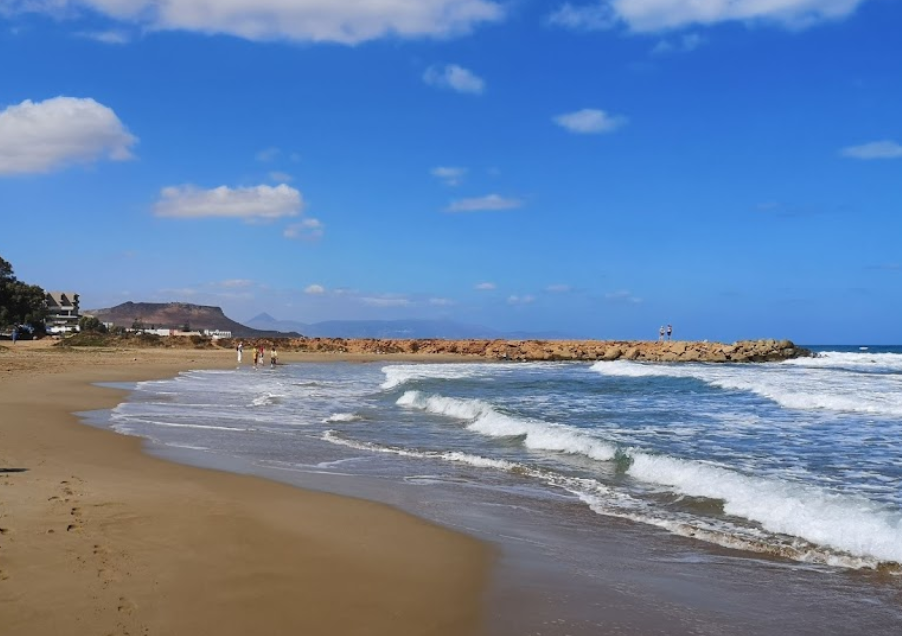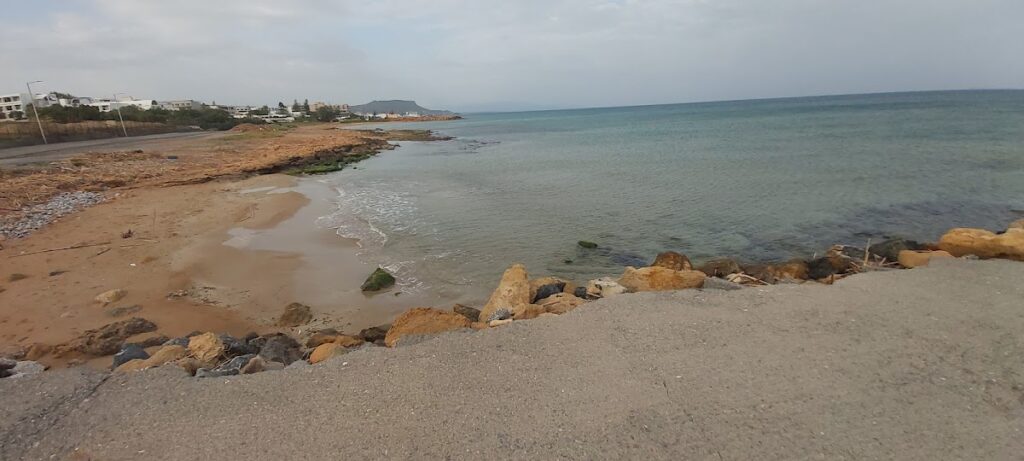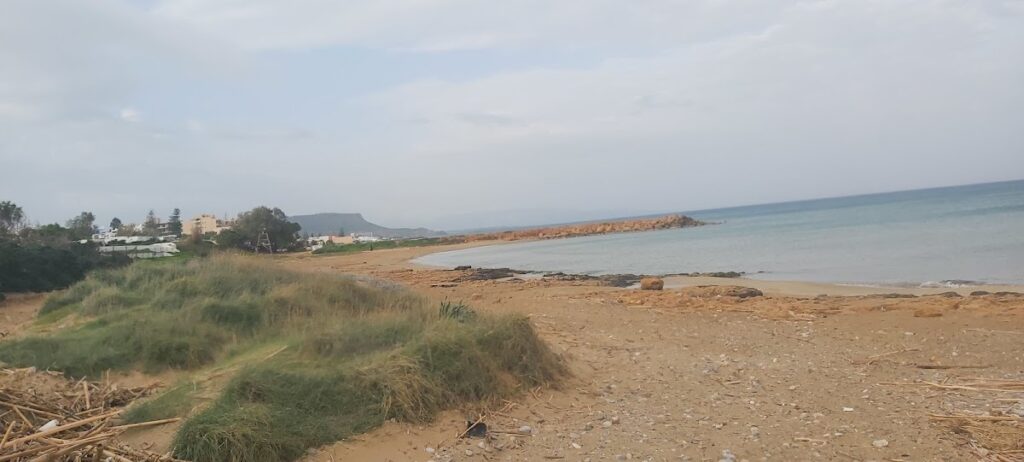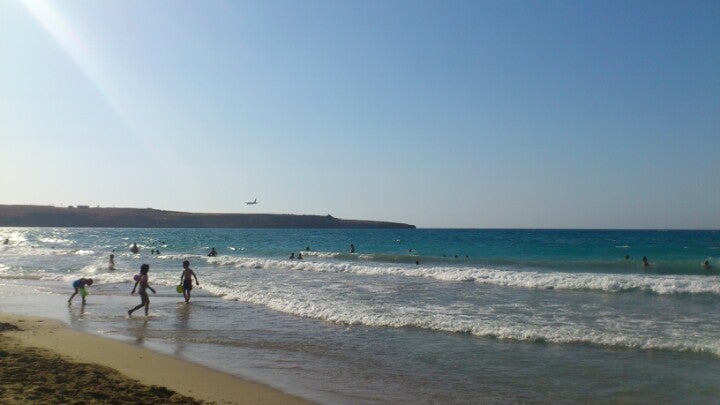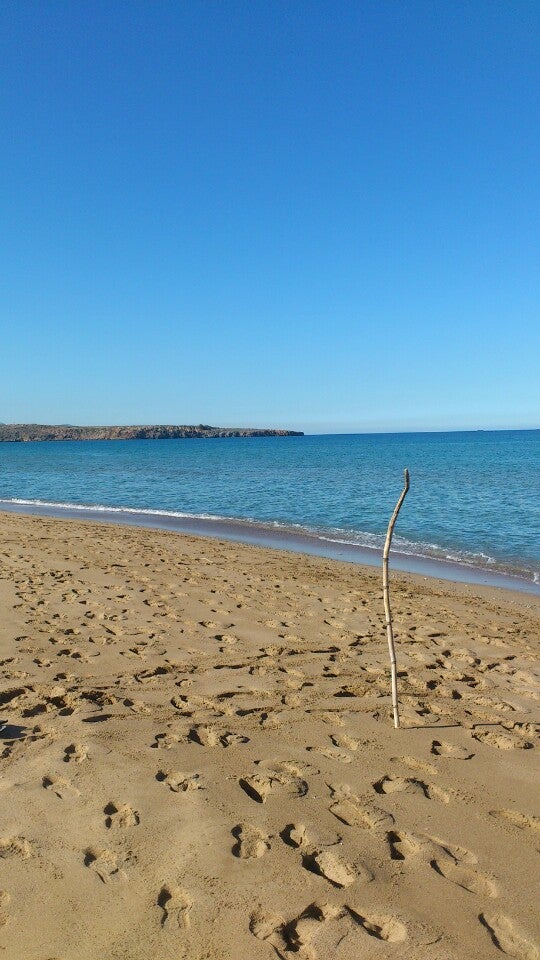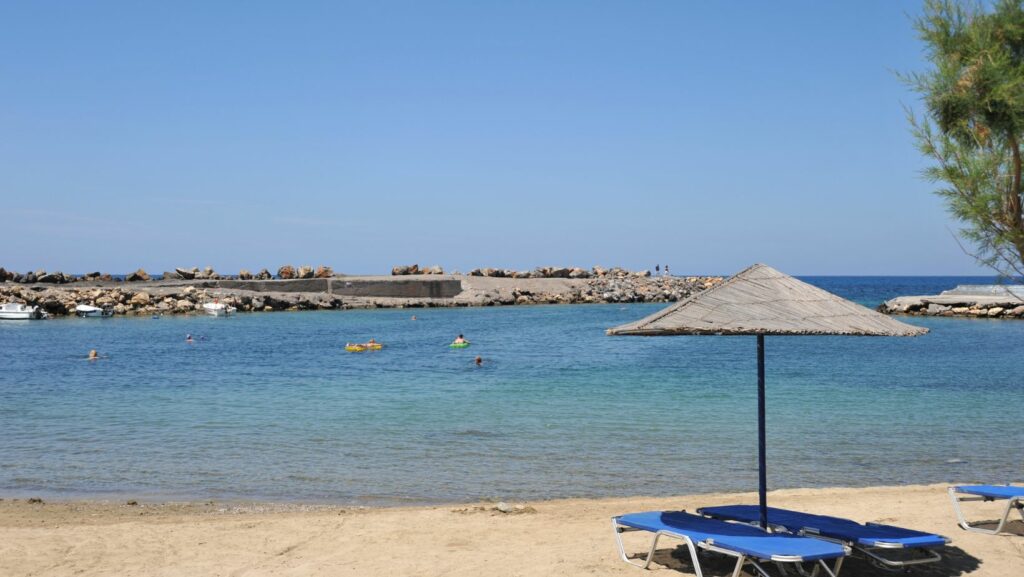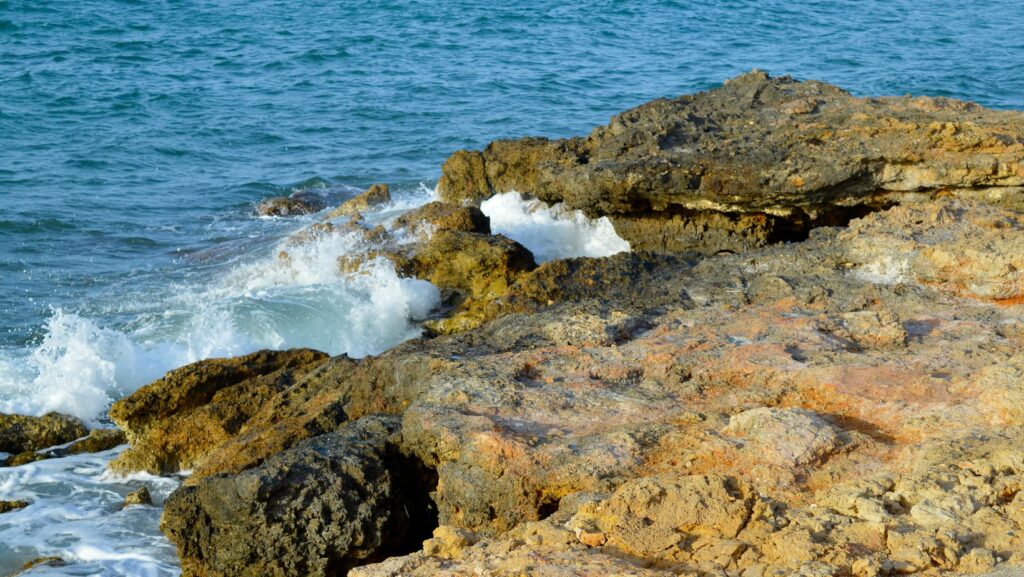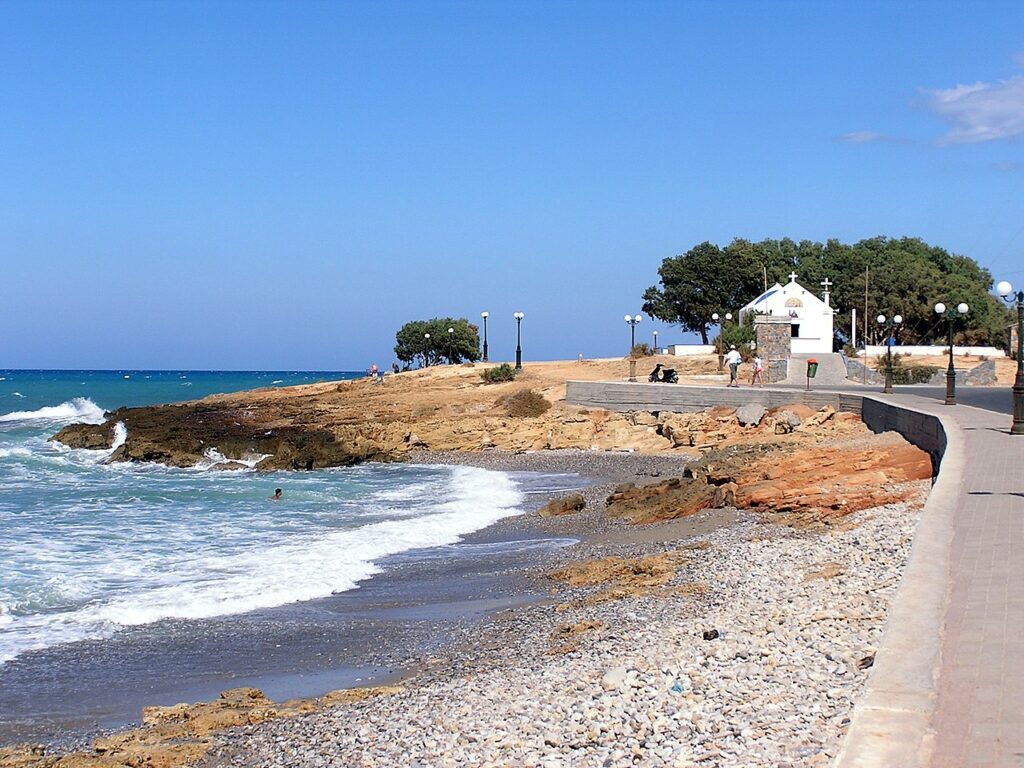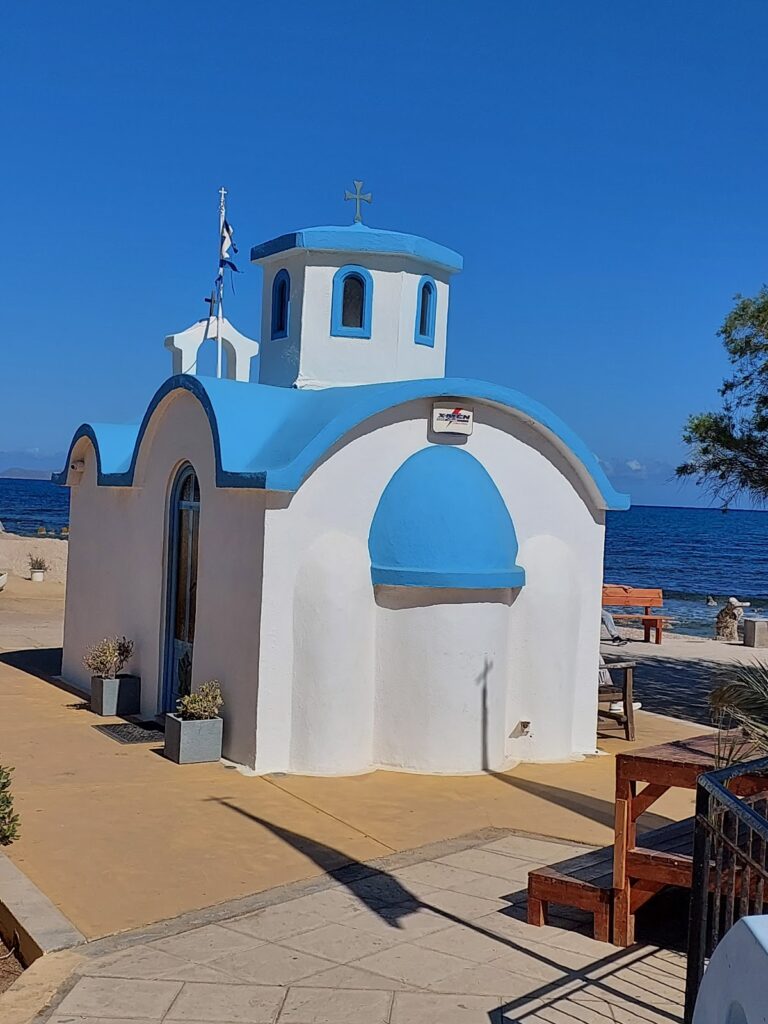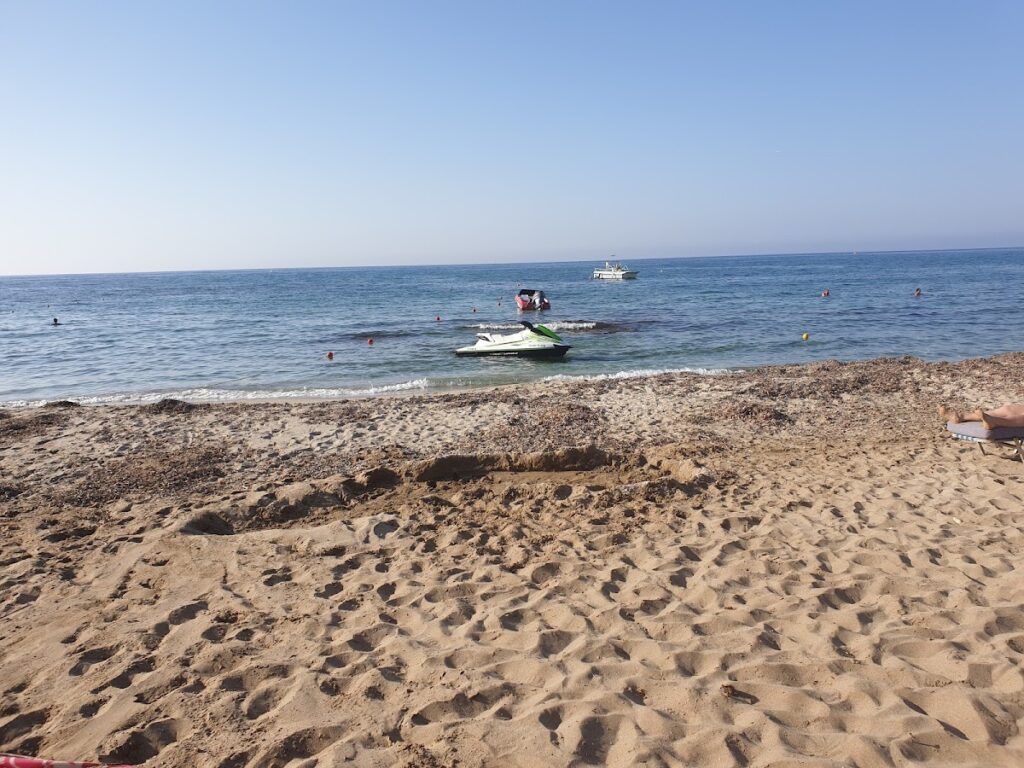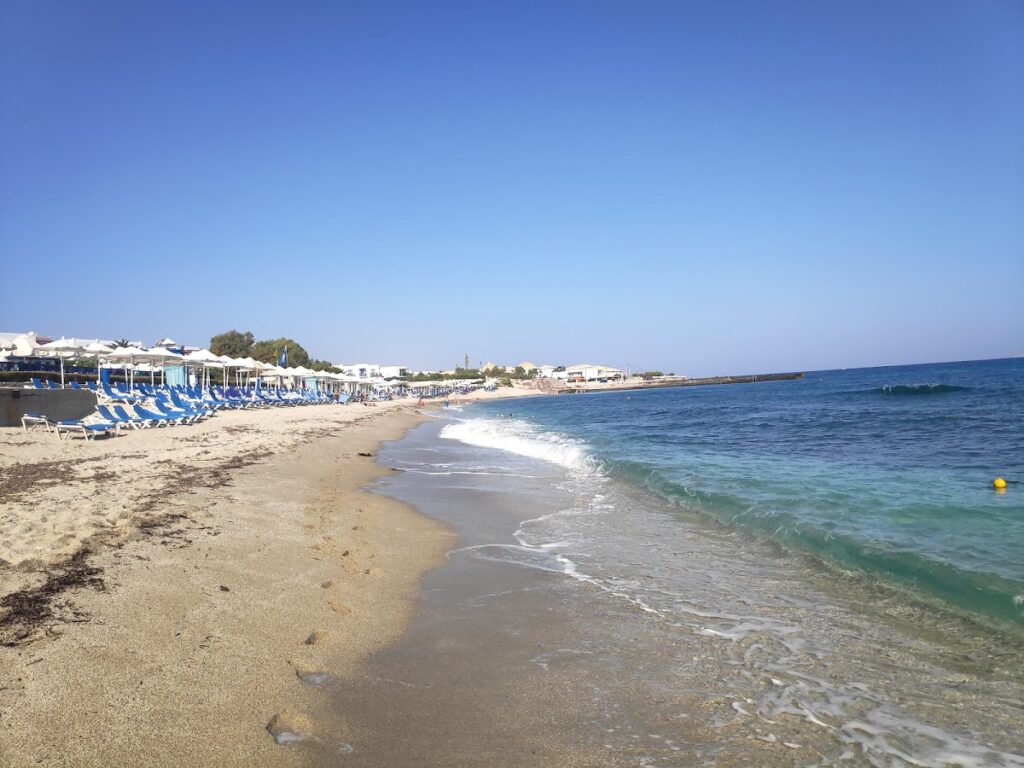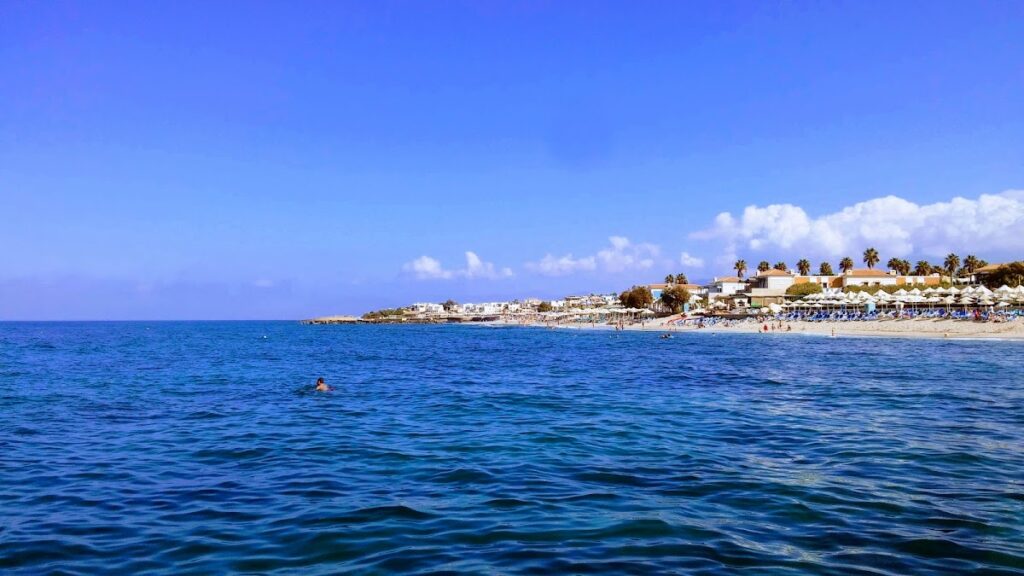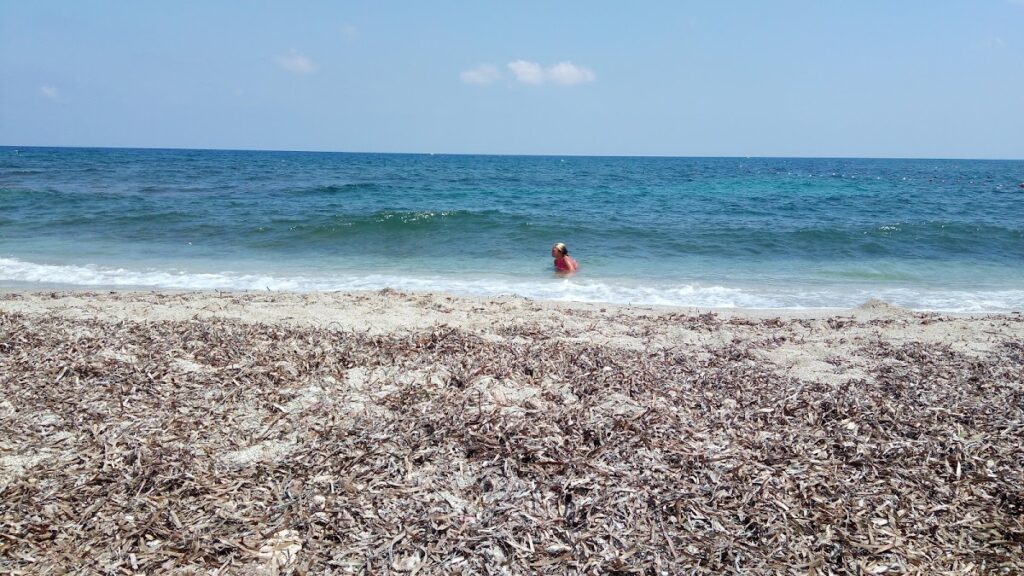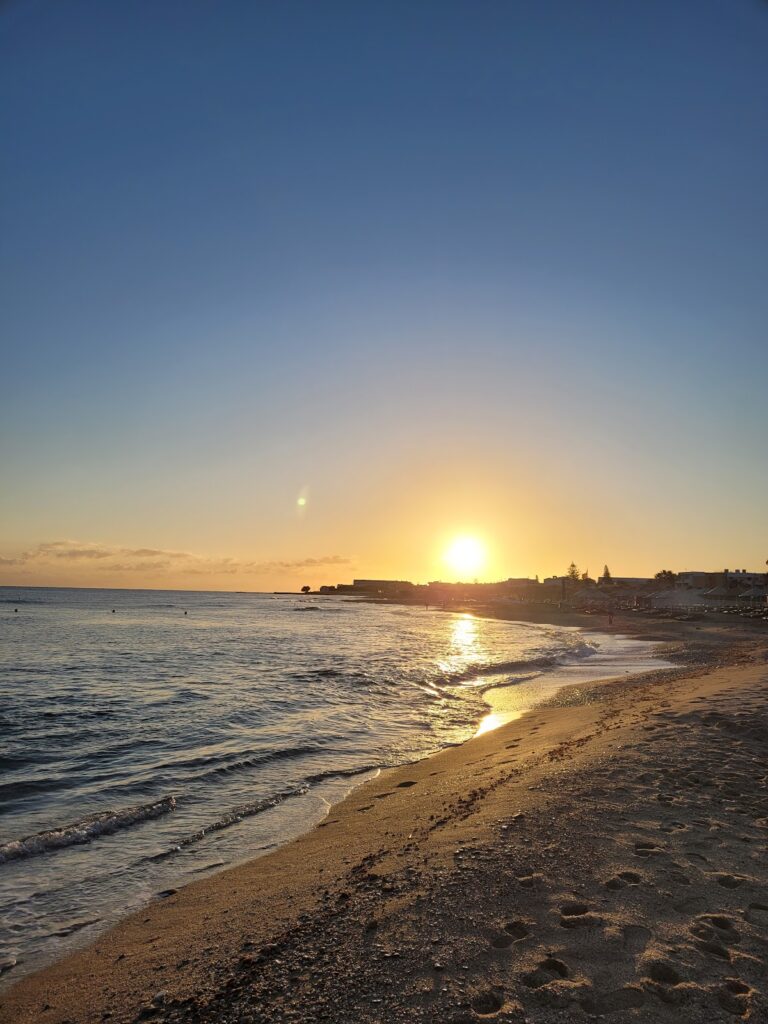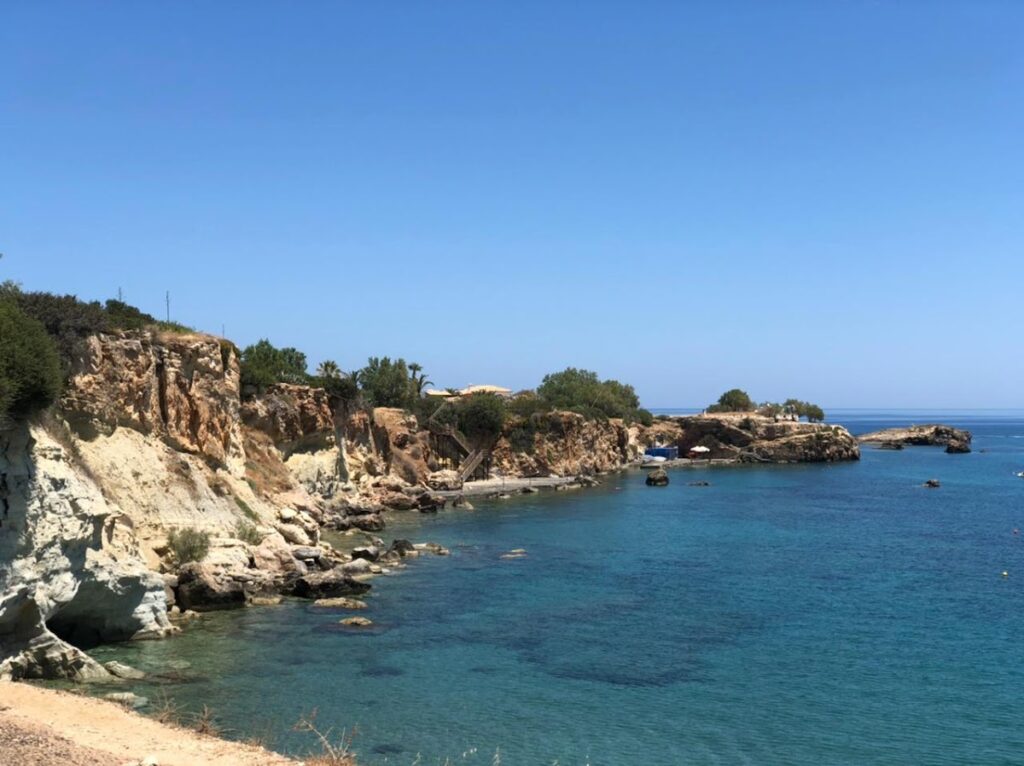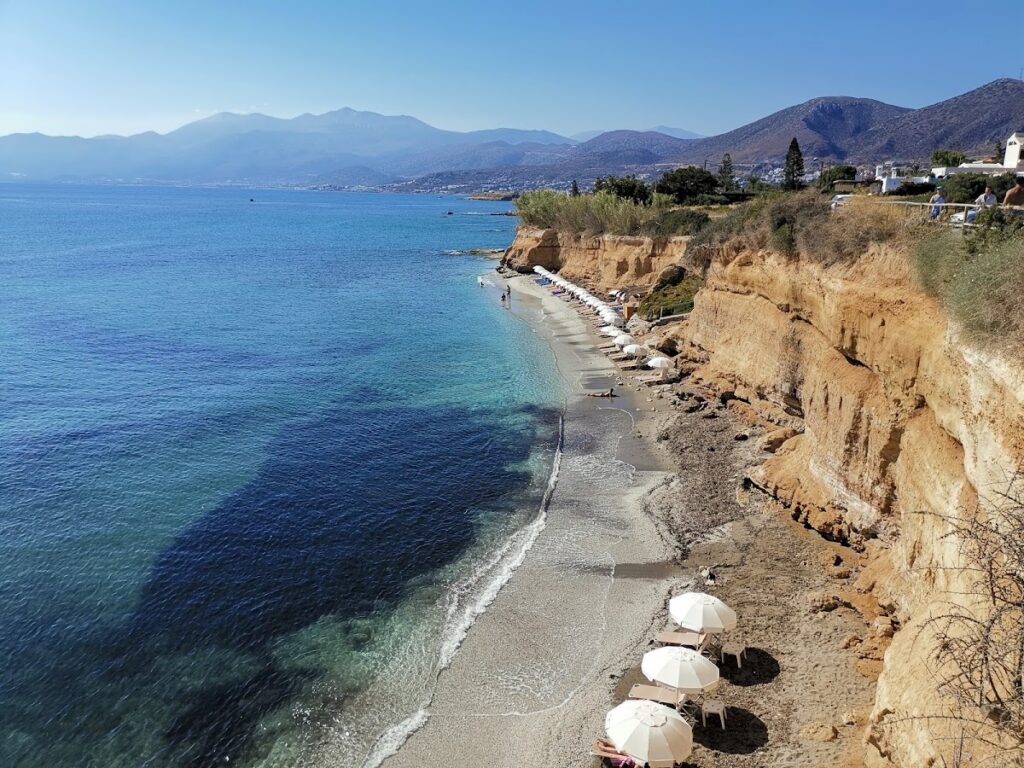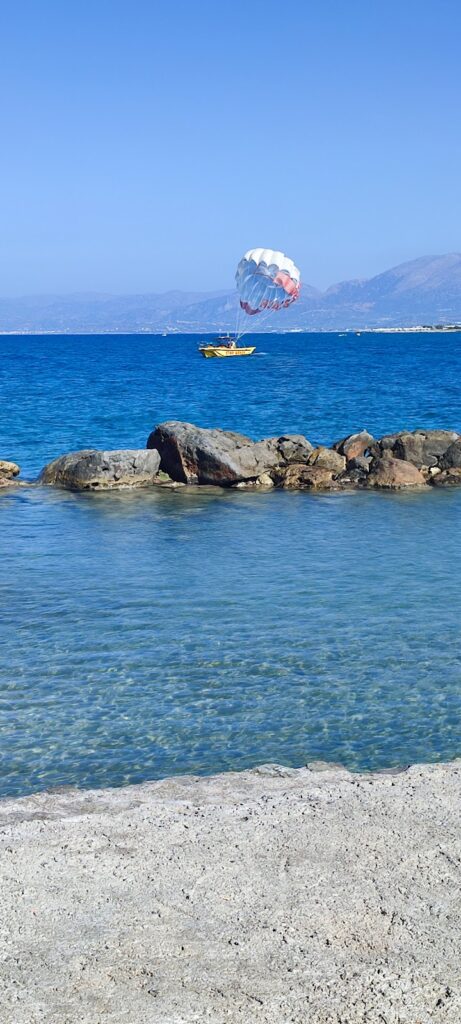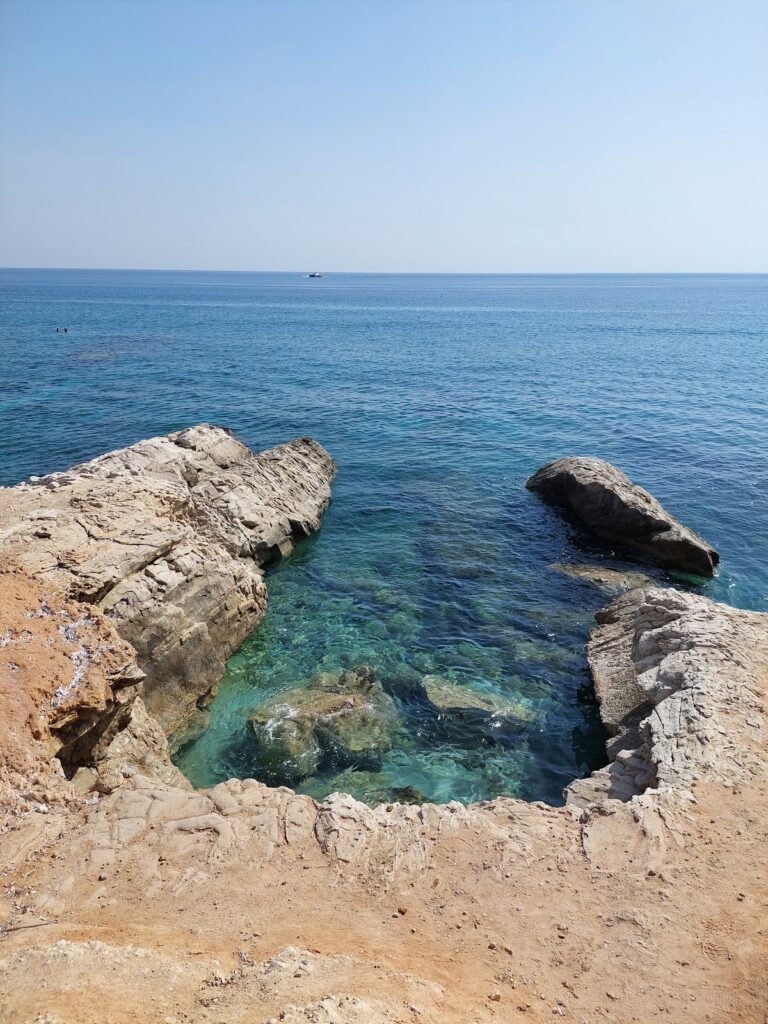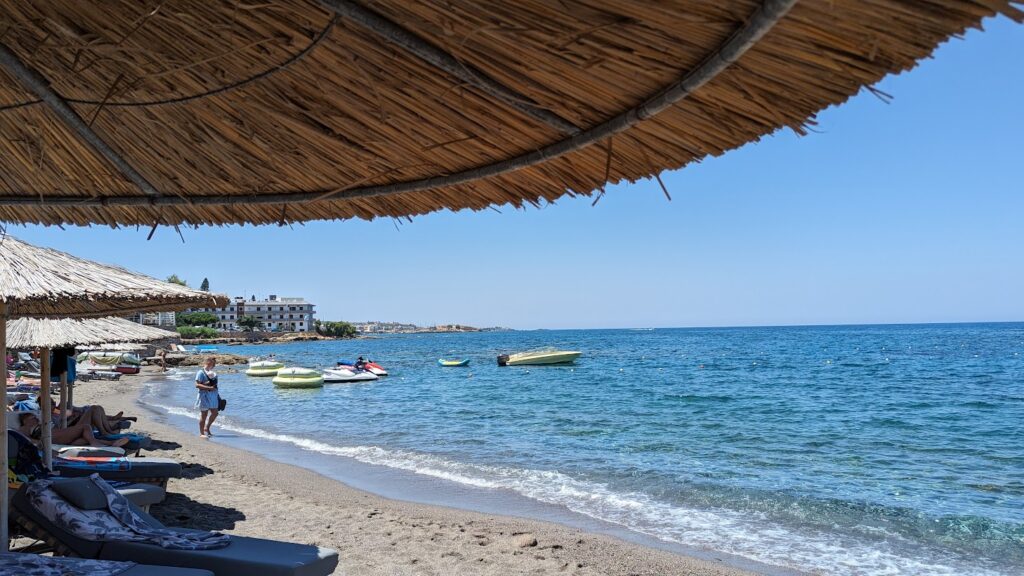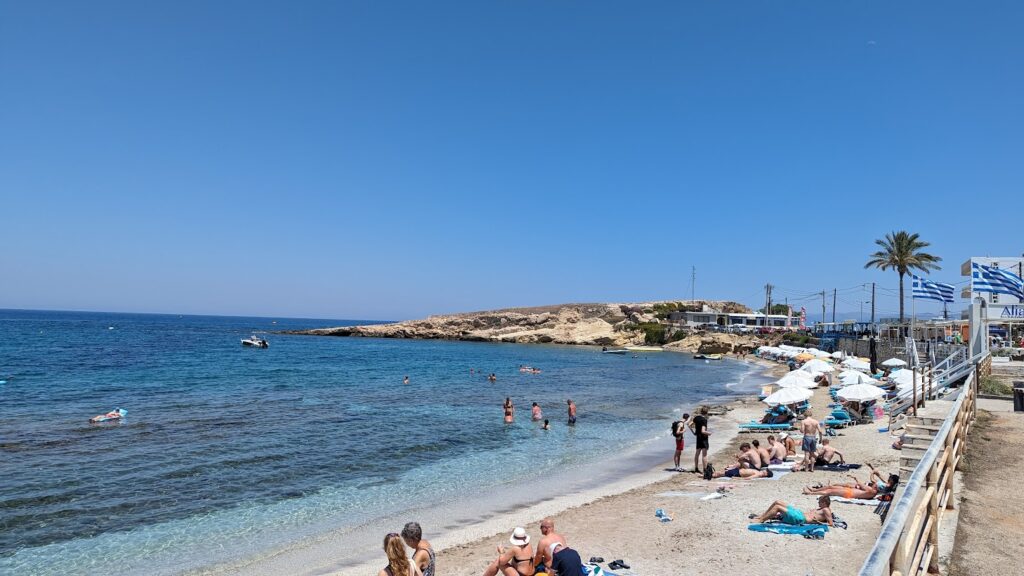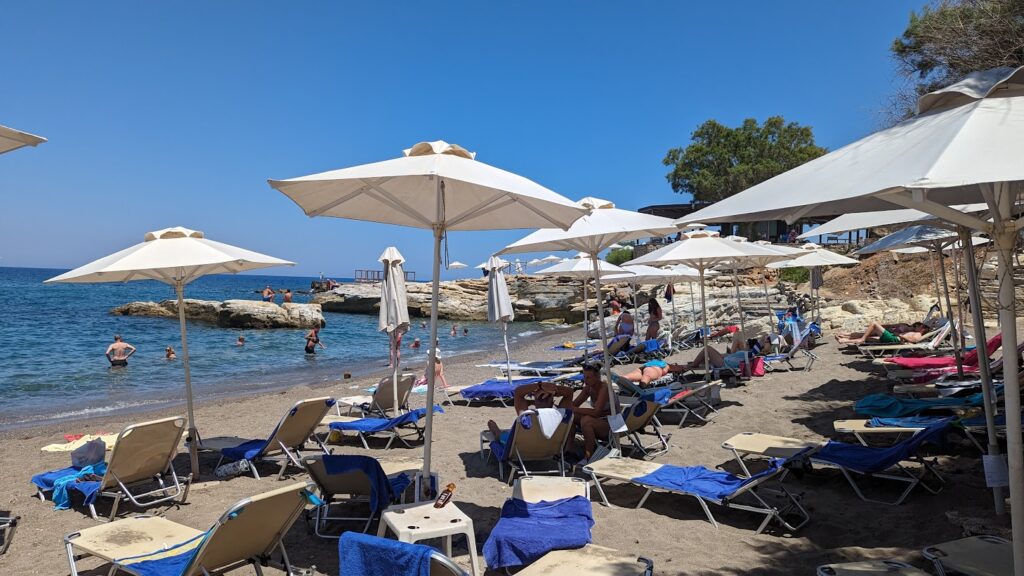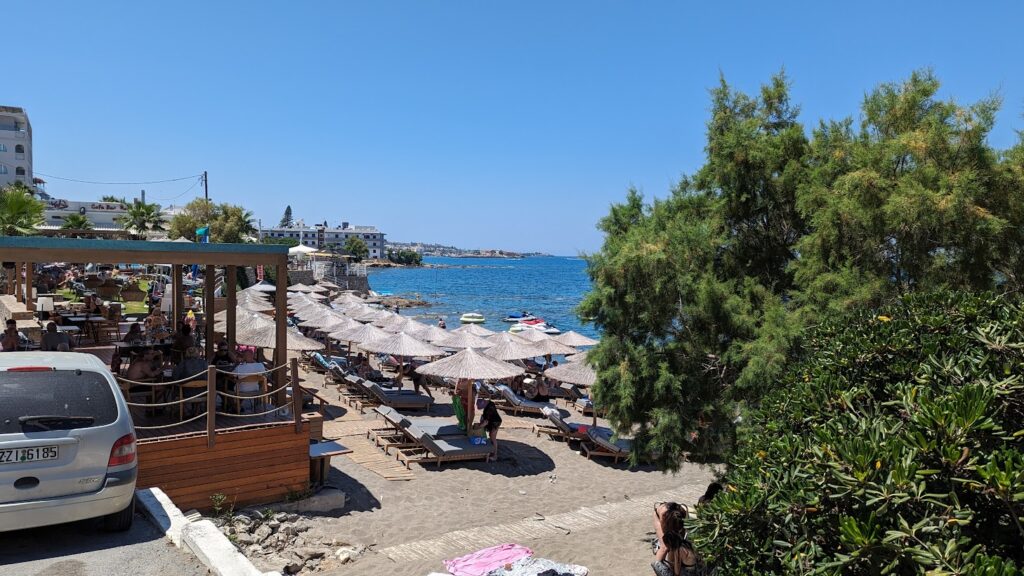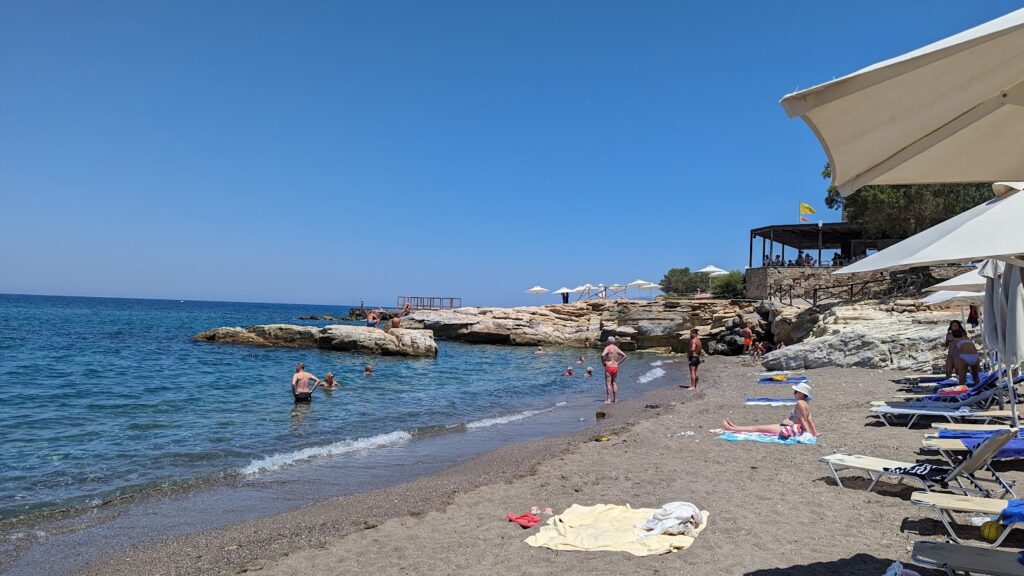Beaches near Káto Vátheia, in Heraklion region
Here is list of closest beaches to Káto Vátheia
- 3.5 km
- Vathianos Kambos beaches
- Sand
- Shallow
- Blue
Situated 15km east of Heraklion lies the well-liked tourist resort of Vathianos Kambos. It derives its name from the nearby village of Vathia, found just a few kilometers to the south. The region is known for the Vathianos River that drains into the area and dries up during the summer. It is characterized by several contiguous bays with golden sands and shallow waters. Due to its north-facing beach front, the area experiences regular wave activity in the months of July and August, leading to the construction of numerous small piers that help to break the waves, retain the sand, and safeguard swimmers.
The most developed beach of Heraklion is found in the westernmost part of Vathianos Kambos, within the Estavromenos settlement. It is widely recognized as Arina, named after a local hotel. This extensive sandy beach attracts thousands of locals who flock there daily for a swim. The beach is teeming with umbrellas, bustling beach bars, and offers a plethora of beach sports options.
Moving east of Arina, you’ll come across the small bay of Agii Theodori. Here, you can still find the carved Minoan shipyard visible in the sea. Further on, you’ll encounter the successive coves of Vathianos Kambos, hidden from the main road due to the hotels interspersed between them. These bays are somewhat protected due to the presence of small piers. Only a handful of locals are privy to these secluded beaches, which extend all the way to Kokkini Hani.

- 4.0 km
- Kokkini Hani beaches
- Sand
- Shallow
- Blue
Situated 15km west of Heraklion and to the west of Vathianos Kambos, Kokkini Hani is a thriving resort, nestled amidst numerous crops grown in the region’s fertile plain. Its name, meaning “Kokkinis’s Inn,” harks back to the early 1900s when an inn run by a man named Kokkinis provided a resting place for weary travellers en route to Heraklion.
The resort boasts numerous beaches, safeguarded by artificial mini piers. Characterized by sandy shores and shallow turquoise waters, these beaches, though located in front of hotels, are open for public access. The resort is replete with shops and restaurants, and the beaches are well-equipped with umbrellas, lifeguards, and water sports facilities, providing all the necessary tourist infrastructure. In comparison to Malia and Hersonissos, Kokkini Hani’s nightlife is rather subdued.
Close to Vathianos Kambos, on Kokkini’s eastern side and near the coast, lies the small archaeological site of Niros Villa. This mansion from the Late Minoan Times served as the dwelling of a high-ranking Minoan priest, presumably overseeing the local Minoan harbour. Open to the public, this site offers visitors a glimpse of the architecture of a Minoan religious structure from 4000 years ago. Excavations at the villa have unearthed several large bronze axes – the emblem of the Minoans, along with jars, offering tables bearing raw clay, and a host of other smaller artefacts.
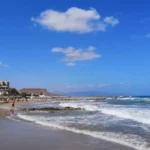
- 4.4 km
- Gournes beaches
- Sand
- Shallow
- Blue
Located 16km east of Heraklion, between Kokkini Hani and Kato Gouves, lies the tourist resort of Gournes. The area of Gournes, originally a separate village, is now part of a 23 kilometer stretch of unified beachfront that begins in Vathianos Kambos and ends in Malia. The fertile plains of Gournes are abundant with vegetable crops and olive groves.
The name ‘Gournes’ is derived from the Latin word ‘urna’ which means water troughs for livestock. However, there is another theory suggesting that the name comes from the Minoan larnakes (urns) that were found in the area.
The beaches of Gournes, like most on Crete’s north coast, are exposed to north winds. The beachfront is dotted with small artificial piers constructed to absorb wave impact and to preserve the sand. This has resulted in the formation of several sandy coves between these piers. The area’s long beach, located on the west part of Gournes, is well organized with lifeguards and umbrellas.
As you head east, the coast becomes rockier and you’ll come across a small torrent. A kilometer further east, you’ll find the former American Airbase of Gournes, which was abandoned in the early 1990s. Despite the derelict buildings, the area is home to the International Exhibition Center of Crete, the Centre for Marine Research (HCMR), the City Hall, and the Aquarium. There is also a small port and the longest beach of Gournes, a beautiful sandy stretch that extends to the beaches of Gouves. Particularly noteworthy is the well-organized municipal beach of Gouves, located west of the Old Base boundary.
During your visit to Gournes, don’t miss the chance to see the old church of the Annunciation in the old village and the picturesque church of Agios Ioannis Pezetis with its ancient frescoes. An excavated Minoan settlement and cemetery nearby have revealed many vases, figurines and seals. One of the most popular attractions in Gournes is the Cretaquarium. Once the largest aquarium in southern Europe, it continues to attract thousands of visitors daily and is located within the former U.S. base.

- 5.8 km
- Karteros beach
- Sand
- Shallow
- Blue
The Karteros Bay, situated at the exit of the synonymous Karteros Gorge, lies 7km east of Heraklion and stretches 3.5km to the east. It pays homage to the Byzantine General, Krateros, who in 824AC attempted to liberate Crete from the Saracens by landing his ships on the bay’s beach, but unfortunately, he was defeated. The bay encompasses two villages, Karteros and Amnissos, which have now merged due to the area’s rapid evolution. The area’s development can be attributed to its proximity to Heraklion and the presence of an exquisite beachfront featuring fine golden sand.
You’ll find numerous hotels, eateries, and beach bars in close proximity to the bay. Karteros Bay is exposed to the northern winds, and as a result, the water tends to be wavy. The water is shallow with almost no rocks, except for a few areas. The least crowded part of the beach is situated next to the “Nikos Kazantzakis” airport, 7km west of Heraklion, known as Florida. This part got its name from an old tavern that no longer exists and is the most serene of all the beaches. Compared to the easternmost beaches, Florida has fewer umbrellas and facilities. The river from the Karteros Gorge empties into Florida, creating a small wetland on the beach, which dries up during the summer. It’s certainly worth a visit, especially in the spring.
While in Florida, you should stop by the old Church of St. John and St. Nikon Metanoite, constructed within a large cave. Moreover, don’t be startled if you spot horses on the beach as it’s home to the Heraklion Riding Club.
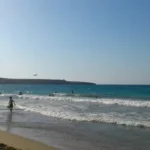
- 6.2 km
- Gouves beaches
- Sand
- Shallow
- Blue
Kato Gouves, often referred to as Gouves, is a sought-after holiday destination nestled 18km east of Heraklion, at the base of Mount Ederi. Historically, the valley of Kato Gouves was a fertile ground for vegetables, olives, and cereals, cultivated by the inhabitants of Ano Gouves. Today, it’s been transformed into a tourism hub, featuring numerous hotels. Unlike the bustling resorts of Malia and Hersonissos nearby, Gouves offers a tranquil vacation experience, making it an ideal spot for families and the elderly. The sandy beaches here are loved by families, and are conveniently close to all necessary amenities.
Gouves beach is well-equipped with facilities such as umbrellas, sunbeds, lifeguards, water sports, and diving centres, alongside showers and changing rooms. The sea, featuring fine sand and shallow waters, is exposed to the common north winds. As a result, there are several small piers and marinas in the vicinity where you can enjoy a swim, shielded from the waves. The coastal road of Gouves runs parallel to the coastline, simplifying the task of locating your perfect beach spot! Enjoy an evening stroll on this road while admiring the sunset. The road also boasts numerous cafes and restaurants, offering panoramic sea views. Furthermore, Gouves’ main road houses a number of supermarkets, shops, pharmacies, clinics, and ATMs.
One must-visit spot is the Church of St. Constantine, nestled in a quaint pine forest adjacent to the sea. Its picturesque seaside location makes it a popular wedding venue, especially for couples from Heraklion. If your visit falls on a Saturday, you’re likely to witness a traditional Greek wedding or baptism. Beyond the shoreline, 2km to the north, lies the village of Ano Gouves. Its narrow streets, churches, and coffee shops exude a traditional charm. Further north, you can explore the Cave of Agia Paraskevi near the village of Skotino. To the east, Mount Ederi stands tall, home to radars used by the Americans for the operation of the erstwhile US air base in Gournes.
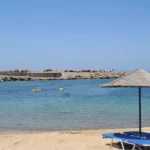
- 8.6 km
- Aposelemis beach
- Sand
- Shallow
- Blue
The Aposelemis River, situated 19km east of Heraklion, between Analipsi and Gouves, is a significant wetland in northern Crete. The pond that forms near the shoreline serves as a natural habitat for various migratory birds and rare species. The river’s outlet gives way to a beautiful sandy beach with shallow cool waters. Although it’s in close proximity to large hotels and tourist spots, the beach lacks organization compared to other top beaches in the vicinity, with only a handful of umbrellas and sunbeds available.
There are two alternative routes to reach the beach. One option is to drive towards the beach of Analipsi and then follow the coastal road heading west. After traversing a few meters past the region’s rocky shores, you’ll arrive at the extensive Aposelemis beach. Alternatively, you can take the coastal road of Kato Gouves to its eastern end, where the road veers right and runs along a hotel’s walls. Aposelemis beach is directly across from this hotel, adjacent to Gouves’ soccer field.

- 10.1 km
- Analipsis beaches
- Rocks in places, Sand
- Normal
- Blue
Analipsi, or Ascension, is a village situated 20km to the east of Heraklion and is named after the Ascension of Christ church. Positioned in a fertile valley, the area is primarily utilized for olive groves. In the early 20th century, it was known as Svourou Metohi, after the Turks who owned land there. Upon Crete’s liberation from the Ottomans, Analipsi was given to the shepherds of Agios Georgios village in Lasithi Plateau as a winter grazing ground. Now, these shepherds’ fortunate descendants own expansive properties featuring hotels, shops, restaurants, and various tourist amenities.
Compared to neighboring resorts, Analipsi is less touristy and more peaceful, making it a preferred destination for families. The village front features a quaint pier with a charming church dedicated to Agia Marina. To the west of the chapel, the coast is rocky, save for a small harbor with a lovely beach. East of the chapel, you’ll find the main sandy beach of Analipsis, which is well-maintained. Though the water isn’t deep, summer months often bring waves.
A leisurely afternoon can be spent wandering through the charming alleys of the old traditional village, admiring the beautiful gardens and stone-paved square. You might also want to visit the four-aisled Ascension church, dedicated to the Virgin Mary, the Ascension of Christ, the Holy Cross, and Saint Efrosinos. The village’s main street, lined with cafes and shops, runs perpendicular to the coast.
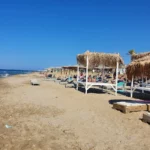
- 12.6 km
- Anissaras beaches
- Fine Pebbles, Rocks in places
- Normal
- Blue
Located 21km east of Heraklion and west of Cape Sarandaris, the tranquil resort of Anisaras is now home to a plethora of large hotels, most of which provide all-inclusive services. Small sandy beaches with rocky seabeds line the front of these hotels, all well-equipped with umbrellas and sun beds mainly offered complimentary to hotel guests.
Although beautiful, the beaches have a generally rocky seabed, making them popular with snorkelers. Regular waves can pose challenges. The beach near Analipsi, however, the longest in the area, is notably sandier. The coastal road of Anissaras starts from here, running along the coast, stopping before the large Anissaras hotel complex, and then extends southwards, passing around the hotels up to Cape Sarandaris. To swim at the hotel-front beaches, one must either stroll along the coast until finding a preferred cove or seek permission from hotel security to cross the hotel grounds.
The small, picturesque chapel of St. George can be found on Cape Sarandaris, offering breathtaking views of Hersonissos’ western coves. It can be accessed by walking eastwards from the hotel beaches or by taking the road that links Anisaras and Hersonissos. Near the cape, a stone footpath leads to the church.
Anisaras is not a structured settlement, but rather a scattering of hotels and holiday homes, limiting dining and entertainment options outside the hotels. However, the close proximity of Hersonissos provides alternatives. Access to Anisaras from Heraklion by bus is slightly problematic, with no direct route available. The buses destined for Hersonissos stop about 2km from the beach, necessitating a taxi.
Contrary to rumors, Anisaras does not derive its name from the plant anise, which is not found in the area. Instead, the name is a corruption of ‘agisaras,’ the Greek name for the plant Cistus creticus (also known as aladania), which is abundant in the region.
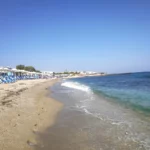
- 13.1 km
- Sarandaris coves
- Fine Pebbles, Rocks in places, Sand
- Normal
- Blue, Green
The tranquil beaches of Hersonissos Coves, also known as Limanakia, are located 27km east of Heraklion, extending from Cape Sarandaris to Hersonissos harbour. The beaches are protected from the strong northwest winds by Cape Sarandaris (Sarantari), providing calm waters for visitors. These coves are easily reachable and are situated near the vibrant town of Hersonissos with plenty of bars and cafes.
The western edge of the coves features a concrete dock ideal for diving, nestled on the rocky western side of Cape Sarandaris (Sarantari) near the quaint St. George Sarandaris chapel. A staircase leads to a sunbathing spot with hotel umbrellas and a rocky seabed perfect for swimming and snorkeling.
Further down, at Cape Sarandaris’s base, you’ll discover the breathtaking Sarantari Cape beach, arguably the most picturesque and sheltered beach in Hersonissos. Its sandy beaches, shallow crystal-clear waters, and an intriguing sea cave make it a tranquil alternative to other beaches, despite the challenging descent through steep limestone cliffs.
Contrary to popular belief, Hersonissos also has a stony naturist beach located next to Sarandaris Cape, hidden discreetly by tall cliffs. This sandy, rocky cove provides a peaceful spot for swimming and solitude.
The well-known Sarandari beach comes next, popular among children due to its shallow waters and soft sands. The beach offers umbrellas, sunbeds, and a small canteen for convenience.
Next to Sarandari is Giofyri beach, situated under the main road and supported by a massive concrete wall. With its unique white coarse sand, deeper waters, and rocky seabed, it’s a popular choice among visitors, complete with umbrella and sunbed facilities.
Heading east from Giofyri along the coastal road, a series of small, slim beaches framed by white rocks awaits, their light-blue waters offering a truly mesmerizing sight. This captivating landscape stretches until you reach the large beach in front of the Creta Maris hotel, which extends up to Hersonissos port. This beach is well-equipped with sunbeds, umbrellas, water sports facilities, and a beach volleyball court, becoming busier and more exposed to winds nearer the harbor.
Regardless of whether you decide to swim, a casual walk from the port to Cape Sarandaris offers stunning views of Hersonissos Bay and St. George’s chapel in Sarandaris. At Hersonissos port, consider visiting the lighthouse and the Agia Paraskevi church, partially built into the rock. On Kastri Hill, the remnants of the early Christian Hersonissos basilica and its preserved mosaics are a must-see.
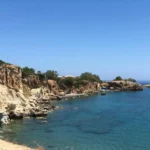
- 13.4 km
- Hersonissos beaches
- Sand
- Shallow
- Blue
Hersonissos, a bustling tourist hotspot in Crete situated just 28km to the east of Heraklion, is renowned for its tranquil beaches and calm seas – a rarity along the northern coast of Crete due to the prevailing northern winds. The most serene beaches can be found to the west of the port, shielded by the Cape Sarandaris. Towards the east of the port, however, lie the resort’s most frequented beaches.
As you venture east from the port of Hersonissos, the first sight to greet you is a sprawling, narrow, sandy beach, buzzing with throngs of beachgoers. It’s impeccably organized and conveniently close to the city’s amenities, though it may not be the best choice for those seeking a more serene environment.
Journeying further east, a series of small, sandy coves become apparent, primarily situated in front of hotels. Of these, Silva Maris Beach stands out with its high level of organization, a lifeguard, and numerous facilities. Continuing eastwards, you’ll encounter Star Beach, one of Crete’s most populous beaches, largely patronized by British and Dutch tourists. Lastly, near Cape Drapanos lie the peaceful beaches of Eastern Hersonissos, offering a quieter seaside experience.

No results available
ResetBeaches in other nearby areas
No results available
Reset





